How to Grow and Use Aloe Vera
This post may contain affiliate links, view our disclosure policy for details.
Learn how to grow aloe vera, from watering and lighting to propagation, plus how to harvest and use this versatile plant for its healing benefits.
Lady Lee’s Note…
They say a dog is man’s best friend, I say it’s actually Aloe Vera. With all due respect for dogs (and I have a lot…), this plant requires almost no care, it doesn’t poop or drool, and it’s going to save you on a regular basis.
I received my aloe vera plant from my ex-mother-in-law something like 20 years ago. I planted it in a pot (we’ll talk more about that later) and to this day, I still grow that same plant. Over the years, there were a few times that I thought that I’d lost it… Too much rain in the summer or a few times I left it outside during a very cold fall night.
Somehow, every time it comes back! I have to do very little for it to just be there by my side… I call THAT… A very good friend!
If you don’t own an aloe vera plant yet, I hope that by the end of this post, you’ll be convinced that it’s the next plant that you need to bring into your life. But for now, let’s start at the beginning…
What is Aloe Vera?
Aloe Vera is a succulent plant, meaning it stores water in its leaves (it’s 94% water). It grows to about 36 inches tall and spreads outward by offsets or “pups” (picture below) to form a wide cluster of chubby leaves.

Aloe Vera is native to Northern Africa. The green (or grey-green) leaves are thick and fleshy with tiny white teeth on their margins. The “teeth” can scratch but are not as bad as thorns. There are almost 300 identified species of aloe vera. Medical aloe vera can be recognized by the faint white spots on the thick leaves.
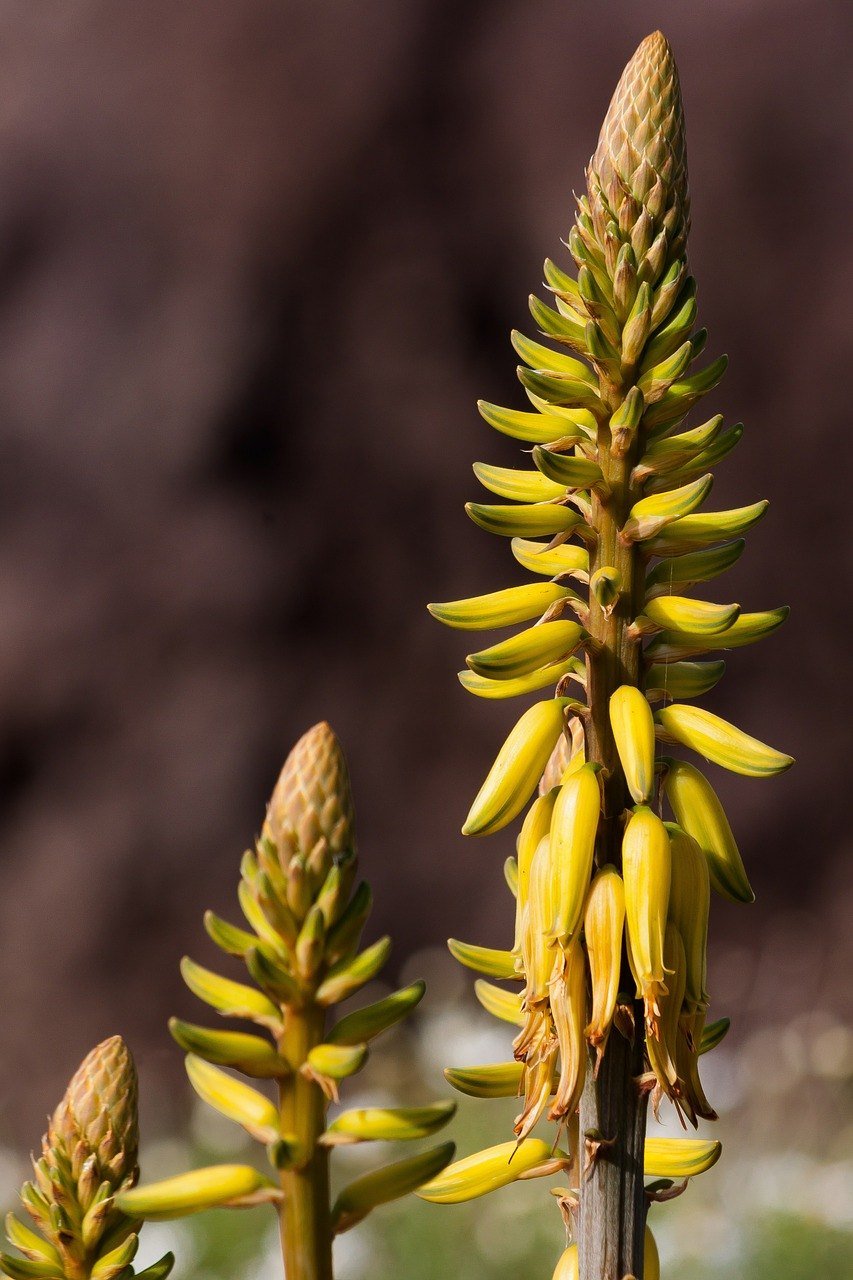
In the desert, aloe vera will produce a flower stem in the spring. It grows from the center of the plant and is 2 to 3 feet tall and topped with tubular pink or yellow flowers.
Where Can I Get an Aloe Vera Plant?
As I said before, I got my aloe vera plant from my ex-mother-in-law after she removed some offsets from her mother plant. If you have a friend or a family member who happens to have aloe vera growing somewhere, you can propagate it by removing an offset. I’ll explain how to do this later in this post.
Your local plant nursery should have aloe vera plants. You might even be able to find it at the farmer’s market. And, of course, like everything else, you can find it on Amazon.
How to Plant Aloe Vera…
The only thing aloe vera doesn’t like is freezing temperatures (32F and below), so…
- Outdoor – If you garden in zones 9-11 you can plant aloe vera outdoors. If you’re planting more than one plant, make sure to space them 3 feet apart since your plants are going to spread outward.
Aloe vera is not picky at all when it comes to soil. As long as you have decent garden soil it will have no problem growing. If your soil is heavy clay, you can mix it with cactus and succulent soil mix or cover it with leaf mulch. - Outdoor/Indoor – In gardening zones 1-8 you’ll have to plant your aloe vera in a container that you can move indoors before the first frost.
Again, you can use cactus and succulent potting mix or you can use a regular potting mix or even some soil from your garden.
You don’t need a very deep container since aloe vera is pretty shallow-rooted. however, if you want to allow your plant to spread, make sure to choose a wide container. Also, make sure you choose a container that allows for good drainage. - Indoor – Aloe Vera is a great houseplant. If you can provide it with 6 to 8 hours of bright light a day, it will be very happy indoors. A sunroom is a great location for an aloe vera plant or maybe a south-facing window. If there is no such location in your home, but you would like to keep your aloe vera indoors, you can supplement it with grow lights.
Note – you might think that aloe vera can handle full sun, and it might if it’s not too hot. But in areas that experience high heat during summer days, it’s better to plant aloe vera or place the pot in a partially shaded outdoor location.
Here, in NC (zone 8a) if I leave my aloe vera in full sun in July or August (temperatures are around 90 – 100 F), it becomes brown and starts to wilt no matter how much I water it.
This was a surprise to me because aloe vera is a succulent and should be able to handle the sun. I also see it in my home country, Israel, growing wild in full sun all the time, but for some reason, it did better for me in a half-shaded spot. Maybe it depends on the humidity. Anyway, keep an eye on your plant and move it to half shade if it can’t handle the sun.
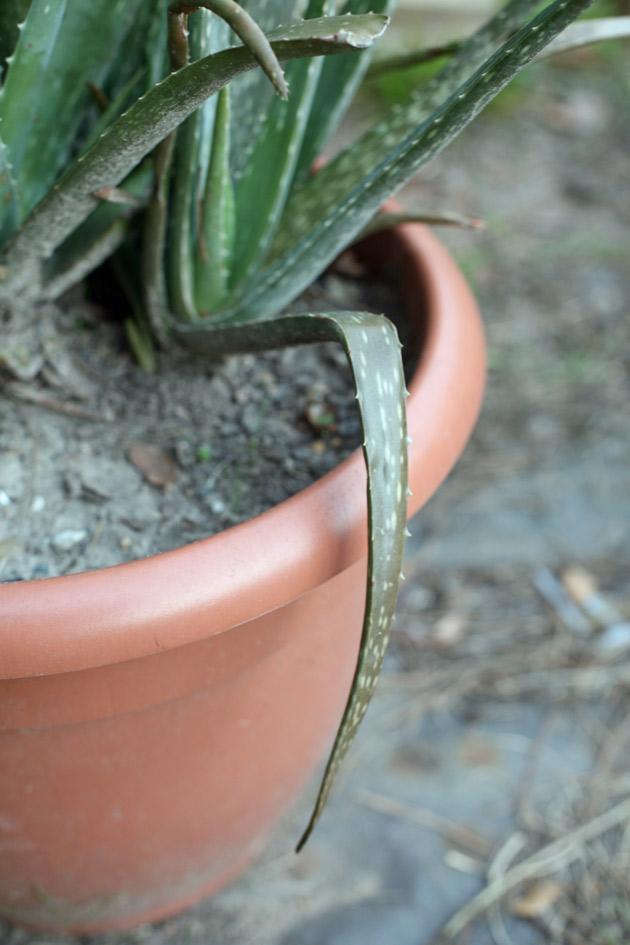
How to Care For Aloe Vera…
Fertilizing – aloe vera doesn’t require fertilizing and will most likely do just fine without it, however, it will benefit your plant if you feed it once or twice a year. I love using worm castings, worm casting tea, or fish emulsion.
Pests – In the 20 years that I have owned an aloe vera plant, I have never had to deal with pests on my plant. Some report scale insects, tiny, brown blob-looking insects that you’ll spot on the leaves. If you happen to notice them, simply remove them by hand. They usually don’t do too much damage unless there are a ton of them.
Watering – I water my aloe vera plant twice a year (maybe). Here, in NC we have a lot of rain in the spring and summer, so when it’s outdoors I don’t water at all. I bring it inside at the end of October and from that time until the beginning of April I water it twice. If your plant doesn’t get any rain, water it twice a month or so.
Note – make sure to not overwater! If you do, you’ll notice that the leaves are starting to wilt and darken. Just stop watering for a while until the plant recovers.
Protecting from the cold – Above you can see a leaf that is becoming brown and starting to wilt. This happened because I left my aloe vera outside when night temperatures dropped to 32F. This will also happen if you leave your aloe vera plant in full sun on very hot days.
So remember to pay attention to the weather forecast, and when it gets too cold, bring your plant indoors and place it close to a sunny window. I usually don’t wait until the frost. When night temperatures drop to the 40’s I bring my plant inside.
Aloe Vera is very forgiving, though… Even if your whole plant has wilted, it will most likely bounce right back when conditions are right. It’s very hard to kill this plant.
How to Propagate Aloe Vera…
Aloe vera grows and multiplies by growing offsets; tiny aloe vera plants that grow from the mother plant around the base of the plant. If your pot is becoming too crowded, or if you would like to give an aloe vera plant to a friend (it’s a great gift!), you can remove some of the offsets. It is better to remove the ones from the sides of the container and not mess with the center of the plant.
Wait until the offset is at least two inches tall (five or six inches is even better). Then, to separate an offset, remove the aloe vera plant from the pot. Brush away as much soil as you can and locate the place where the offset is connected to the parent plant. Cut it off right there, the offset should have a few roots.
Replant the mother plant in its pot, it might be a good time to add new soil and refresh things a bit. Then, plant the offset in its own pot and you are done. Make sure to place the plants in a well-lit location but away from direct sun.
If your aloe vera plant is planted in the garden, you’ll have to gently dig around the offset to find where it is connected to the mother plant and disconnect it. Then, dig it out carefully and replant it.
How to Harvest Aloe Vera…
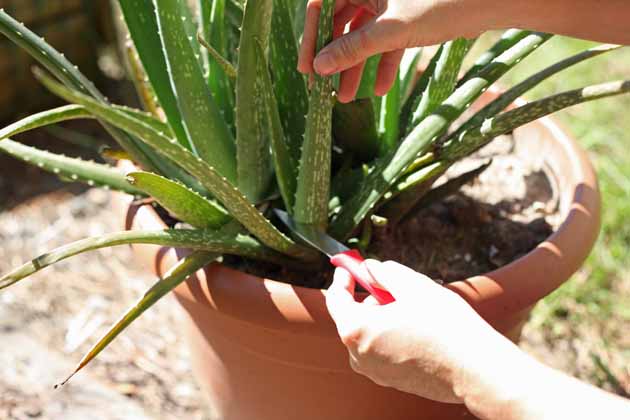
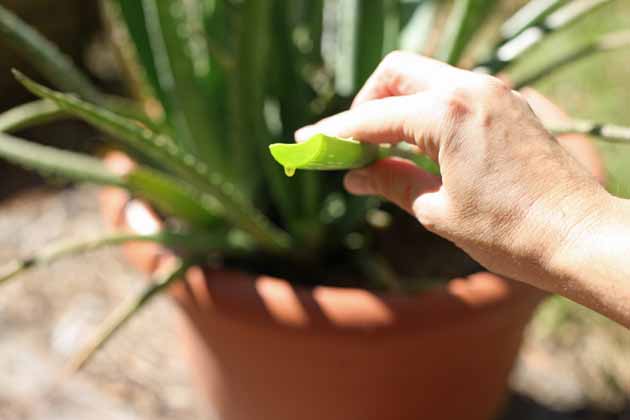
When your aloe vera plant is established and fully grown, you can start using it. To harvest aloe vera, cut one of the leaves. See this goodness that is coming out of the leave? This is what you want to use.
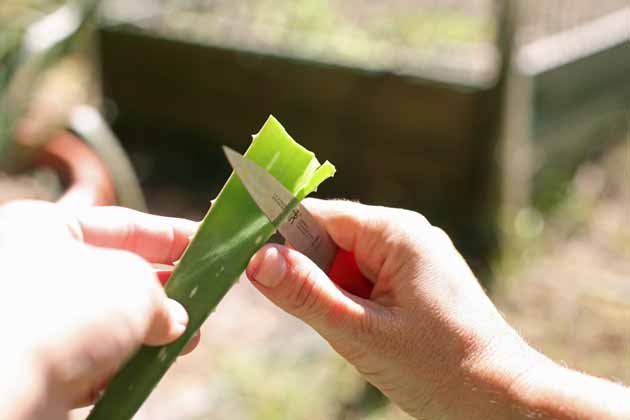
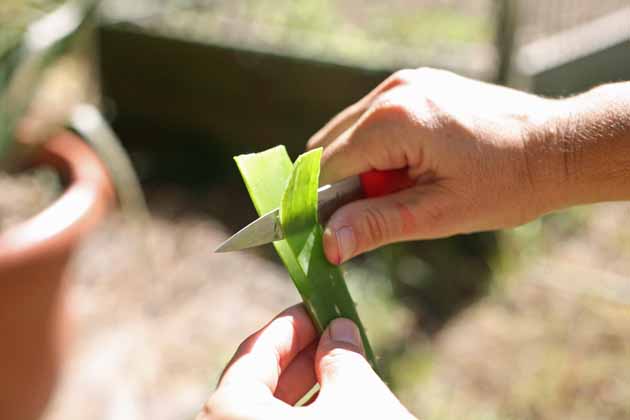
To better access the inside of the leaf cut the white teeth from one sides, then peel the front of the leaf to allow you better access to the gel inside.
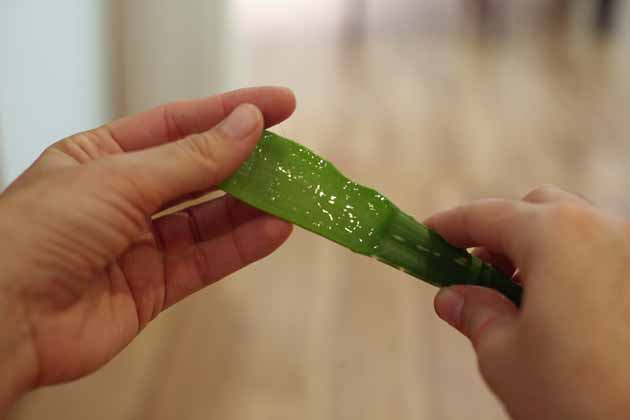
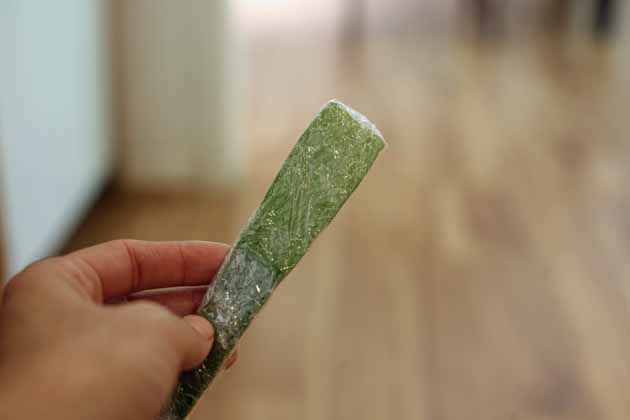
See the gel inside of the leaf? This is the part we want to use. Below, we are going to talk about aloe vera uses, but just so you know, you can wrap the leaf in plastic wrap and keep it in the refrigerator for next time. When you need it again, unwrap it, peel another piece and use it. Don’t throw it away if you didn’t use all of it the first time.
How to Use Aloe Vera…
The aloe vera plant produces two substances that we can use as medicine. The gel is clear and comes from the inner part of the leaf, and the latex is yellow and is found right under the skin (you’ll notice it when you cut the leaf). There are two main ways to use aloe vera: externally and internally.
Externally – both the gel and the latex are used externally (applying to the skin) to heal the skin and support healthy mouth and teeth and healthy hair and scalp. Here is a list of skin problems aloe vera can help heal by applying the gel on the skin:
- Burns
- Itchy skin due to insect bites (it can help with chigger bites)
- Sunburns
- Skin damage due to frostbite
- Athlete’s foot
- Rushes
- Blisters
- Prevent and heal acne
- Reverse wrinkles and treat signs of skin aging
- Treat eczema
- Reduce puffiness under the eyes
- Strengthen gums
- Treat hemorrhoids
- Strengthen teeth (use toothpaste with aloe vera in it)
- Treat minor vaginal discomfort
- Remove makeup
- Fight dandruff by massaging into the scalp
Internally – aloe vera is used internally mainly by drinking aloe vera juice. To make aloe vera juice from your plant, peel a piece of leaf, so you are left with only the gel (the inner, clear part of the leaf). Add this to a blender with a cup or two of orange juice or mango juice (or whatever else you like), blend well, and drink. Using aloe vera this way can help…
- Strengthen the immune system
- Treat indigestion and constipation and support a healthy digestive system (therefore, aloe vera can help with weight loss)
- Treat arthritis and relieve joint pain
- Treat heartburn
- Lower blood sugar
- Treat stomach ulcer
- Treat hemorrhoids
- Treat UTI and prostate problems
- Reduces cholesterol and supports a healthy heart
- Helps to reduce and treat inflammation and infection of the eye and ear
- Improve the look and health of the skin
- Help keep the body balanced between acidity and alkalinity (aloe vera is alkaline).
- Removes toxins
- Improves hair growth
You can learn more about aloe vera’s health benefits in this article.
Aloe Vera is an amazing medicinal plant that has been used for thousands of years. Fortunately, it’s very easy to grow. For just a little bit of care, we get a plant that has so many uses and health benefits. I hope that this guide convinced you to own one!



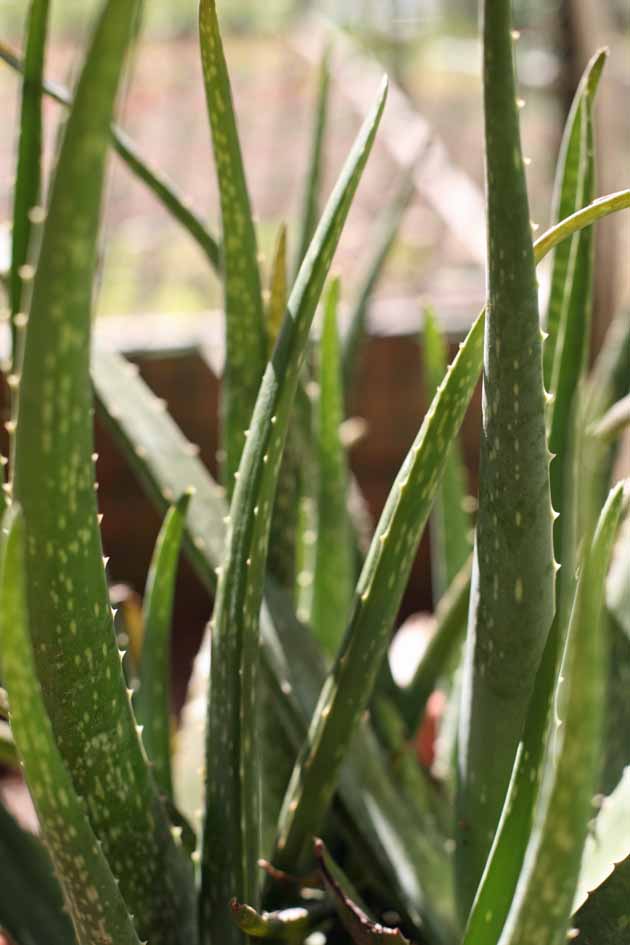
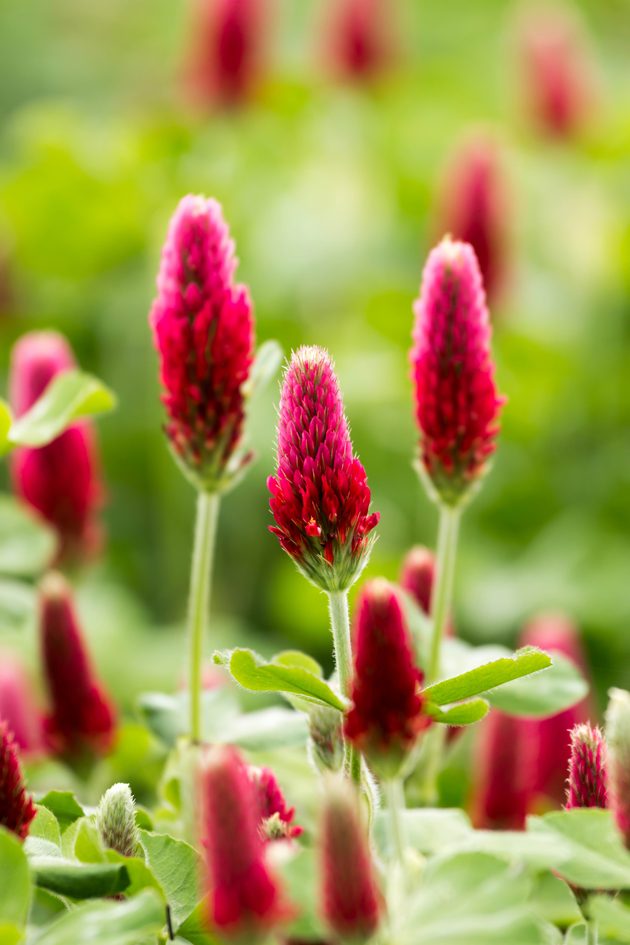
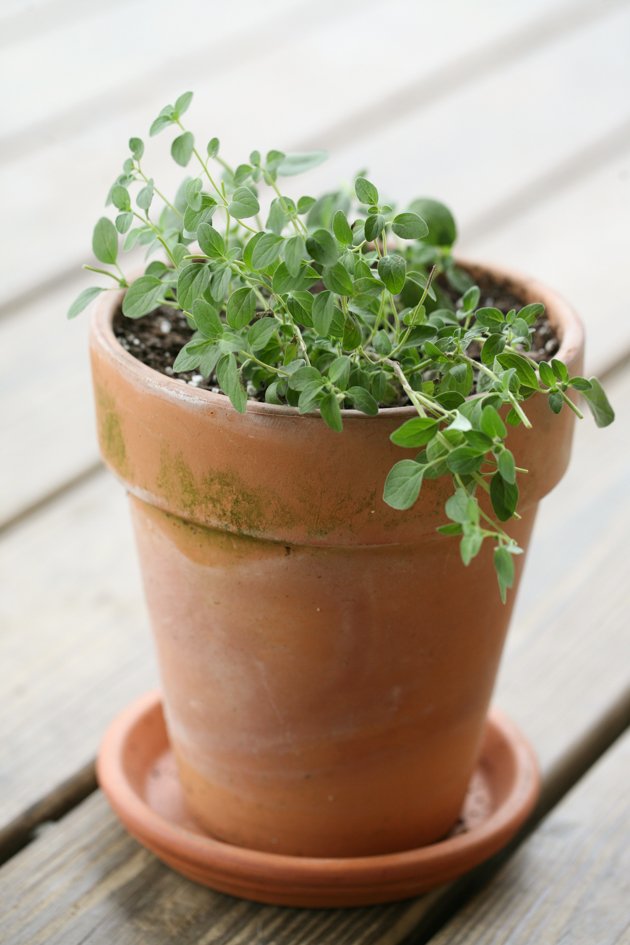

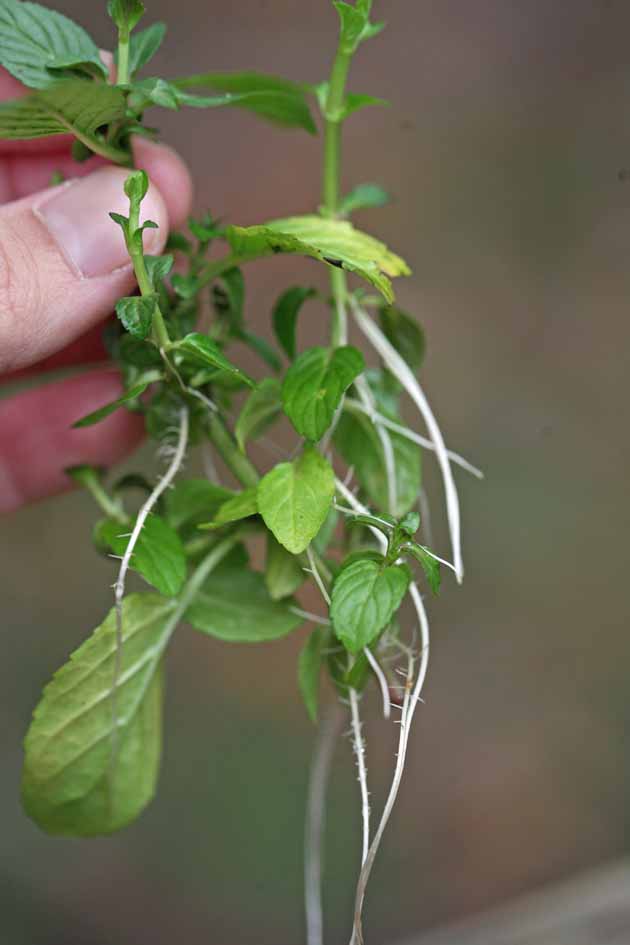
Thank you for all your valuable information in how to care for aloe plants and the many uses of the gel inside! Again, thank you and God bless all you do for others.